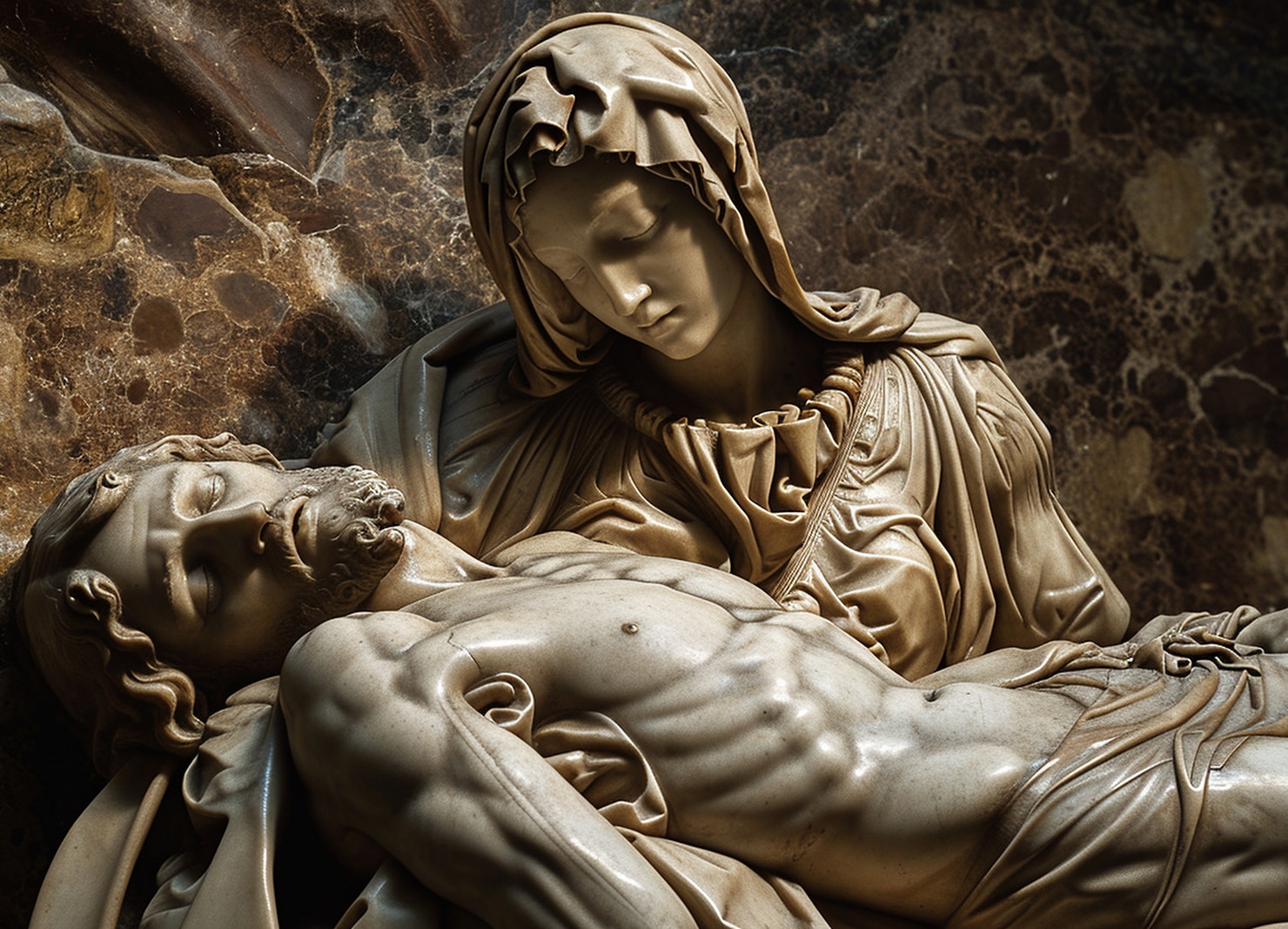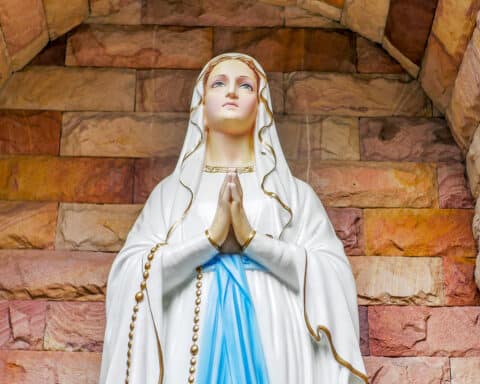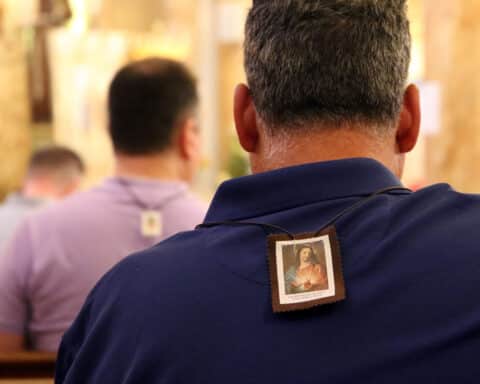When God gives us sanctifying grace in baptism, what he gives us is a share in his own divine life. The spirit of God is poured into our hearts (cf. Rom 5:5). The Spirit, in turn, forms our hearts into a likeness of the eternal Son (cf. 2 Cor 3:18). Just as an iconographer reproduces the face of Christ on wood, so the Spirit reproduces the sonship of Christ in our hearts (cf. Rom 8:15). The more we are conformed to Christ in our hearts, the more we turn with him and like him to the “Father of lights” (Jas 1:17) We learn to worship the Father “in spirit and truth” (Jn 4:24).
“When Jesus saw his mother and the disciple there whom he loved, he said to his mother, ‘Woman, behold, your son.’ Then he said to the disciple, ‘Behold, your mother.'” (Jn 19:26-27)
The Third Last Word
Yet, all of this takes place gradually. Just as a seed planted in the ground is meant to grow, so the grace of God planted in our hearts is meant to grow too. Slowly does the Spirit bring to completion the image of Christ in us. Slowly do our hearts learn to trust completely in the mysterious ways of the Father. Slowly, our hearts come to burn with love for God and neighbor. Much of the time, perhaps, we feel little taking place. Indeed, we might even live in pain. Though God has been generous with his grace towards us, our lives are often full of afflictions of every kind. The same afflictions that bear down upon all of humanity bear down upon Christians too — even more so in some ways. Our transformation by grace does not mean an end to all our sufferings, but a change of heart amid many sufferings.
St. John the beloved disciple
Even while suffering, we can receive the greatest of graces. One of the best examples in all of Scripture is St. John. At first, he became a disciple of Jesus, but in time, he became the friend of Jesus. According to venerable tradition, John was the beloved disciple who reclined at the breast of Jesus during the Last Supper. St. John was privileged to hear the sacred heart beating in the chest of Jesus. The love of Jesus so captivated him that the eyes of his own heart became illuminated. He became a contemplative soul. The eyes of his heart became completely fixed on Jesus — the eternal Truth.
When the hour of Calvary had arrived, all of the Twelve fled except for St. John. Only the contemplative remained. He remained standing at the foot of the cross. It was without doubt the most tormenting trial of his life to watch his innocent friend be crucified before his very eyes. Yet, amid the suffering, he was granted an awe-inspiring grace.
Words addressed to all
“When Jesus saw his mother and the disciple there whom he loved, he said to his mother, ‘Woman, behold, your son.’ Then he said to the disciple, ‘Behold, your mother'” (Jn 19:26-27).
With these words, the Lord was not simply making housing arrangements for his mother or asking his beloved disciple to put her up for some time. Jesus was actually giving his own mother to St. John to be his mother too. It is a sublime grace indeed to receive the Mother of God as one’s own personal spiritual mother, and it pleased the Lord Jesus to bestow such a grace upon his friend John. Such a grace, however, is in no way reserved to John alone. John symbolizes us all.
When reading the Gospel of John, Christians spontaneously recognize that when Jesus speaks to certain individuals, he is speaking to you and me. When the Lord speaks to Nicodemus (cf. 3:1-21), to the woman at the well (cf. 4:4-42), and to the man born blind (cf. 9:1-41), what he says to the one individual he says to us all. His words are addressed to you and me. So, too, when the Lord speaks to the beloved disciple standing at the foot of the cross. “Behold, your mother” is addressed to us all.
Turning to Mary
“Behold your mother” is one of the last words of the Lord. It was his dying wish for us to receive her and respond to her as our mother too. It is a divine call for you and me to relate to the Mother of God with all of the love and confident expectations that children have with their own mothers. For, thanks to the gift and grace of Jesus Christ, Mary is truly our mother, too, in the order of grace.
Christians have always turned to Mary and gathered with her in prayer. After the death and resurrection of the Lord, the disciples spontaneously returned to the upper room. They gathered for prayer together with Mary the mother of Jesus (cf. Acts 1:14). Christian artists and iconographers down through the ages commonly depict the scene in the same way. Mary is in the center at prayer and the disciples are gathered around her as tongues of pentecostal fire descend upon them all.
Confidence in Mary
The act of gathering with Mary in prayer did not end in the upper room. Even after she was assumed into heaven, it has continued down through the centuries. One of the oldest hymns on record is called the Sub Tuum. It has been found written in Greek on a fragment of Egyptian papyrus. Some scholars date the fragment to the second century. Although the hymn was written down in the second century, it was likely chanted for years before it was ever written down at all. Conceivably, it goes back to one of the earliest Christian communities. The hymn is short. It sings only of essential things, and it goes as follows:
“To you do we come seeking mercy, O Mother of Christ our God. Do not turn away, nor despise our prayer, but be pleased to hear our plea. Entreat your Son, our God, to save our souls.”
The hymn reveals a certain confidence in Mary and sends up a petition to her. It displays no sense that Mary can do anything for us on her own apart from Jesus Christ but expresses the simple confidence that she will go to Jesus Christ with our petitions. She will not stand aloof from our concerns or our lives. She will not despise us so. She will plead with her Son to give us new graces, and, in so doing, she will exercise her special spiritual maternity in our lives. Through her intercession, God will bring to completion the good work he began in our souls at our baptism.

For Mary knows better than we do what the life of grace really means for each of us. She knows that God has poured the grace of the Holy Spirit into our hearts. She also knows what work the Spirit is carrying out in each of us. She knows the Spirit is the iconographer of Christ in our hearts. She knows well the face of Jesus, and she knows where each of us is in the process of coming to resemble him. She knows the particularities of the plan of God for each of us, and she is ever at prayer for the Spirit to bring his work in our hearts to completion — for each of us to grow “to the measure of the stature of the fullness of Christ” (Eph 4:13, RSV). She prays for us to turn with Jesus and like Jesus to the Father of lights.
Growth of grace in each of us
Just as mothers on earth are keenly interested in the life and growth of their children, so Mary is keenly interested in the life and growth of grace in every one of us. She prays us to the waters of baptism. She marvels at the new life that begins in each soul through that sacrament. She sees the life of grace in each of us as the extension and effect of the life she conceived in her own womb.
Just as mothers on earth are keenly interested in the food and nourishment of their children, so Mary takes a particular interest in each holy Communion we receive. She knows each holy Communion will energize and vitalize the life of grace in our souls. She understands more than we do the inconceivable power of the body and blood of the Lord to stoke the fire of divine love in our hearts. She understands how the Eucharist actively unites the whole Church in heaven and on earth into one mystical body of Christ. The Blessed Virgin Mary prays for each person at each holy Communion to receive the effects of the sacrament to the full. The same holds for the other sacraments too. She cares immensely about every trip to the Sacrament of Penance, every anointing of the sick, every priest, and every marriage.
Once we see Mary as our mother, it only makes sense to fly to her for prayer. It only makes sense to ask her: “Entreat your Son our God to save our souls.” Indeed, it only makes sense to abandon all care for our lives into the hands of Mary our mother.





